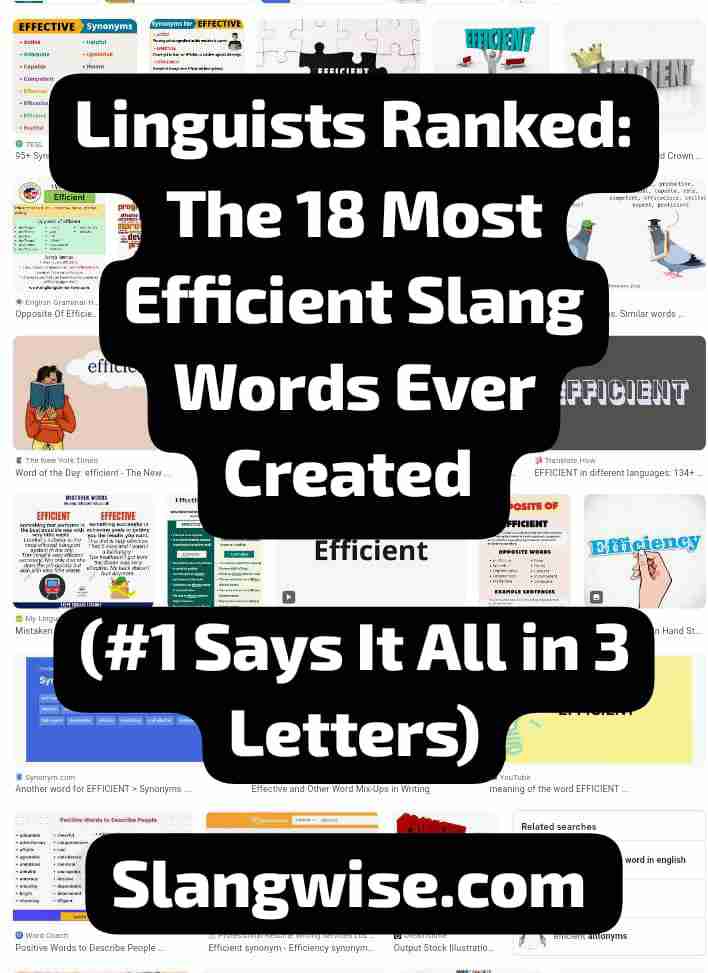Language evolves at the speed of culture, and nowhere is that swiftness more evident than in slang. The most efficient slang words do more than shorten speech: they encapsulate nuance, emotion, and social cues in the smallest package possible.
Below, eighteen of the most efficient slang terms ever created are ranked, #1 truly says it all in just three letters, and each comes with a real-world example to show it in action.
Table of Contents
In a nutshell
- Brevity with impact: The eighteen slang terms below pack rich meaning into just one to four letters, making conversations faster and more vivid.
- Cultural resonance: Each term transcended its origin, online chat rooms, TV shows, or everyday speech, to become a global staple.
- Adaptive simplicity: From casual “k” to emphatic “OMG,” these words slip seamlessly into spoken language, text messages, and social media.
- Enduring efficiency: Decades after their birth, these slangs remain widely understood, proof that true linguistic efficiency stands the test of time.
SlangWise thought: “Great slang doesn’t just save characters, it conveys tone, emotion, and identity in the blink of an eye.”
18. k – Okay; acknowledgment.
Why it’s efficient: One letter. One keystroke. “k” is the ultimate minimalist acknowledgment: quick to type, immediate in meaning. It’s efficient because it both acknowledges receipt and ends the exchange without extra words.
That single-letter reply has a lot of tone packed inside, depending on context it can be neutral, curt, or even passive-aggressive, but its economy is undeniable. The use of single-letter responses predates texting (hand signals, telegram shorthand), but “k” became globally recognizable with SMS and instant messaging.
Example: “See you at 6?” — “k”
17. u / ur: “you” / “your” or “you’re”
Why it’s efficient: Replacing three or four letters with a single character (or two) speeds typing dramatically on phones and keyboards. These shorthand forms trace back to early SMS and pager culture when character limits mattered.
Their efficiency lies not only in fewer keystrokes but in preserving natural sentence flow: readers instantly map “u” to “you” without extra decoding. In online speech, “ur” also evolved to signal casualness and intimacy among peers.
Example: “R u free later?”
“Is that ur jacket?”
16. ty / thx: Thanks” / “Thank you.”
Why it’s efficient: Gratitude often needs a brief and polite sign-off. “ty” and “thx” do that with minimal effort. “Thx” adds a consonant that mimics the “nk” cluster, while “ty” is even quicker.
Both forms emerged from chatrooms and SMS as quick politeness tokens that don’t interrupt the flow of conversation. They keep tone friendly without the formality or length of the full word.
Example: “Sent the file. Thx!” – “ty – got it.”
15. omw – On my way
Why it’s efficient: A perfect small-phrase replacement when you’re en route. Rather than typing “I’m on my way” or “heading out now,” “omw” signals imminent arrival quickly.
The abbreviation rose with mobile texting and ride-sharing culture, where quick status updates are key. It’s efficient because it conveys both motion and imminence in three letters.
Example: “Lunch at 12?” – “Yep. OMW.”
14. FYI – For your information
Why it’s efficient: FYI prefaces facts or disclaimers without oddly formal phrasing. Originating in memos and email in professional settings, it migrated naturally to casual chat because it flags relevance without forcing a long lead-in.
It’s concise and signals to the recipient: “This is something useful or interesting; file it mentally.” FYI’s efficiency is both practical and social, no frills, just context.
Example: “FYI, the cafe closes at 3 on Sundays.”
13. nvm – Never mind
Why it’s efficient: When a question or statement is rescinded, “nvm” is the perfect undo. It shrinks a four-syllable phrase into three characters, preventing awkward follow-ups and saving a stop to the conversation.
It emerged during SMS/IM eras where correcting or rescinding quickly mattered, and it persists because it softens conversational turns without blocking momentum.
Example: “Can you pick up milk?” – “Nvm, I found some.”
12. pls / plz – Please
Why it’s efficient: One short marker keeps politeness intact even in rapid-fire messaging. “pls” is utilitarian and neutral; “plz” carries a slightly playful edge.
Both preserve etiquette with minimal typing, which makes requests feel less abrupt than a bare imperative. They’ve been staples of texting and chat culture for decades.
Example: “Send the notes, pls.”
11. ttyl – Talk to you later
Why it’s efficient: Though four letters, ttyl serves as a handy full-sentence replacement: it closes a conversation politely and signals future contact.
It was born in instant messaging and retains a friendly, non-final way to pause a chat. Its efficiency lies in replacing multiple words with one compact signal that preserves relationship warmth.
Example: “Gotta run – ttyl!”
10. ikr – I know, right
Why it’s efficient: Agreement, emphasis, and shared sentiment in three characters. “ikr” expresses understanding plus a bit of validation, exactly what “I know, right?” does, but condensed.
It’s popular in social media comment threads and DMs, where rapid affirmation keeps momentum. The structure is compact, conversational, and emotionally clear.
Example: “That pizza was life-changing.” – “ikr”
9. yo
Yo is a versatile greeting or attention-grabber.
Why it’s efficient: Two letters, one syllable, and instantly signals friendliness or a call to attention.
It dates back to Middle English but reemerged in the 20th century as urban vernacular, spreading through hip-hop culture and film.Today, “yo” bridges generations: it feels casual yet respectful, perfect for quick check-ins.
Example: “Yo, are you coming to the game tonight?”
8. sup – Short for What’s up?
Why it’s efficient: By dropping “what’s,” “sup” becomes a one-syllable ping that invites a response without fuss. It gained popularity in text messaging and early instant-messaging platforms, surfacing in sitcoms and youth culture.
The term’s utility lies in its dual role as both greeting and conversation starter.
Example: “Sup? Haven’t seen you since high school!”
7. nah – Informal negation, no
Why it’s efficient: Three letters capture a dismissive refusal more expressively than “no.” Its nasal vowel and ending “h” add attitude, signaling lighthearted rejection or disinterest.
“Nah” rose to prominence in African American Vernacular English (AAVE) and quickly permeated mainstream media.
Example: “Wanna grab pizza?” – “Nah, I’m good, thanks.”
6. meh
Meh means: Indifference or lack of enthusiasm.
Why it’s efficient: A single syllable that perfectly transmits boredom or ambivalence. Famously popularized by The Simpsons in the late 1990s, “meh” filled a gap where English lacked a precise term for shrug-worthy apathy.
It’s now standard in text, speech, and even subtitles when translators need a neutral reaction.
Example: “How was the movie?” – “Meh, I’ve seen better.”
5. BTW – By the way
Why it’s efficient: It prefaces a tangent or extra note, and three capital letters save precious time and space in messaging. Born in early internet forums and email chains, BTW has become so ubiquitous that some speakers even say each letter aloud in conversation.
Example: “I’ll meet you at 7. BTW, don’t forget to bring the tickets.”
4. SMH – Shaking my head
Why it’s efficient: Conveys disapproval, disbelief, or exasperation in text form. Rather than writing “I can’t believe this,” SMH does the work in three characters. It emerged in chatrooms and SMS culture before migrating to social platforms like Twitter and Instagram.
Example: “He forgot our anniversary… again. SMH.”
3. BRB – Be right back
Why it’s efficient: Announces a brief absence without derailing chat. BRB was a staple of IRC and AOL Instant Messenger in the 1990s, and its concise form became a blueprint for countless other acronyms.
Today, people still rely on BRB to signal a quick coffee run or phone call, no elaboration needed.
Example: “Hold on, BRB, my phone’s ringing.”
2. IDK – I don’t know
Why it’s efficient: Inquisitiveness and uncertainty meet efficiency. Users swap the four-word phrase for this three-letter acronym to admit ignorance or seek information.
IDK’s swift adoption in texting and online comment threads reflects the universal need to acknowledge gaps in knowledge succinctly.
Example: “What time is the concert?” “IDK, check the website.”
1. LOL – Laughing out Loud
Why it’s the king of efficiency: It encapsulates amusement, irony, or playful tone in almost any conversation. Introduced on Usenet forums in the early 1980s, LOL evolved from literal laughter to a multifunctional marker of tone, sometimes even softening critique or indicating sarcasm.
Its three letters convey humor, camaraderie, and shared digital culture all at once, hence its unrivaled status in the slang pantheon.
Example:
“You actually thought that worked? LOL.”
Why these slangs were efficient
Each of these eighteen slang words shares common traits that underpin their longevity:
- Minimalist structure: One to four letters keep typing speed high and cognitive load low. Single-letter responses like “k” and letter-substitutions like “u” maximize time savings.
- Emotional clarity: Whether it’s laughter (LOL), exasperation (SMH), or indifference (meh), the emotion behind the word is instantly recognizable. The best slang compresses affect as tightly as content.
- Versatile usage: Many of these terms work across spoken, written, and visual contexts, chat apps, social media posts, subtitles, or face-to-face banter. Abbreviations like FYI and BTW also function in professional and casual settings, increasing their reach.
- Community validation: They spread through subcultures, tech forums, urban youth, sitcoms, and then receive broad adoption, cementing their place in mainstream language. Early adopters validate a term, and mass adoption cements it.
Why efficiency matters in slang
Efficient slang enhances communication by:
- Speeding up exchanges: Quick shorthand fosters more dynamic conversation, particularly online where attention and characters are limited.
- Enriching tone: Abbreviations carry emotional and social cues that plain text may lack, helping avoid misread intentions.
- Strengthening group identity: Shared slang signals belonging to a community, be it gamers, millennial parents, or social media natives.
- Fueling language evolution: These compressions push English toward greater adaptability and innovation; efficiency begets further efficiency.
Concluding Thought: impact and future prospects
Though digital platforms accelerate slang creation, only the most efficient, and emotionally resonant, terms endure. Linguists note that brevity coupled with expressive power often predicts which acronyms or neologisms will survive.
As voice-to-text and augmented reality reshape how people communicate, expect new forms to emerge. Yet, the core principle remains: the best slang says the most with the least.
Looking ahead, abbreviations like “FYP” (For You Page) or “OTP” (One True Pairing) may join this elite list if they prove equally concise and versatile.
Meanwhile, single-character signals and emoji pairings will likely continue to evolve alongside these abbreviations, sometimes augmenting them, other times replacing them.
But few will match the universal, cross-generational appeal of “LOL”, a three-letter triumph that forever changed how the world laughs online.

